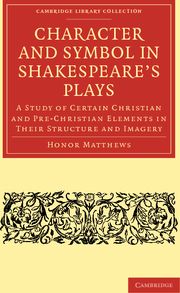 Character and Symbol in Shakespeare's Plays
Character and Symbol in Shakespeare's Plays Chapter VII - The New Imagery and the Final Synthesis
Published online by Cambridge University Press: 07 September 2010
Summary
The preceding analysis has, it is hoped, demonstrated that while the final plays include much that is traditional in Shakespeare's work, the sources of their dynamism must also be sought in new country. The tap-root of the dramatist's imagination appears to be feeling its way towards deeper strata of association, until at last the familiar struggle between justice and mercy is reflected afresh in the imagery of a pagan world, and a new—or it may be a more ancient —conclusion is voiced.
The Christian Church, in spite of its great seasonal festivals, has never made extensive use of seasonal imagery, and in as far as it does so its central symbol is the child born in mid-winter—‘a thing of pity’—rather than the man risen in the spring. But although such material had only a small place in Christian thought and therefore in medieval written drama, it had of course existed in dramatic or semi-dramatic form from time immemorial—as indeed it still exists today in plays of St George and of the Hobby-Horse, the Revesby Sword Play, the Furry Dance of Helston and countless other local celebrations. The May games, already noticed in connection with the symbol of Birnam Wood, made an underground connection with the figure of Robin Hood, and probably the earliest secular written drama in English is the fragment concerning Robin Hood and the Sheriff of Nottingham. Robin and Maid Marian are associated with the king and queen of the May by the version of Robin Hood and the Potter, printed in 1560 under the rubric: ‘Here beginnethe the plays of Robin Hoode, verye proper to be played in May Games.’
- Type
- Chapter
- Information
- Character and Symbol in Shakespeare's PlaysA Study of Certain Christian and Pre-Christian Elements in Their Structure and Imagery, pp. 188 - 208Publisher: Cambridge University PressPrint publication year: 2009First published in: 1962


